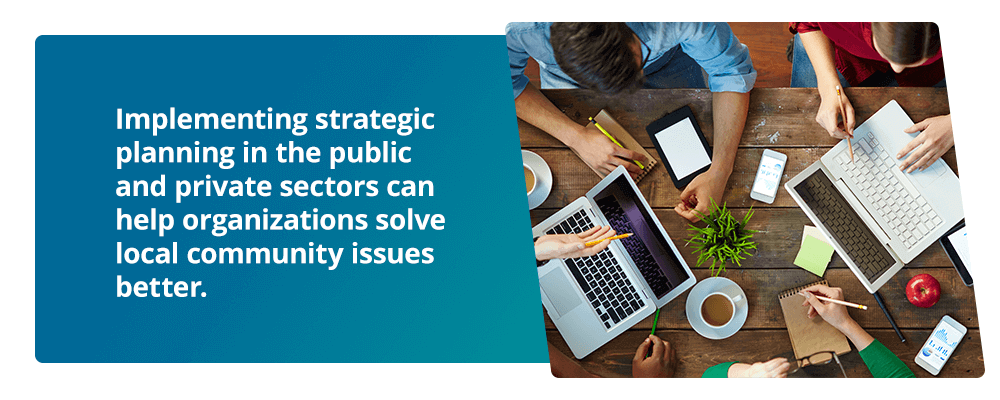When it comes to applying strategic planning from the private sector to the public sector, your organization should understand the plan’s importance and the differences between public and private sector operations. Learn how you can take private sector strategies and implement them in private sectors within the government.
In This Article
- The Importance of Strategic Planning in Government
- The Intersection of the Private and Public Sectors
- Strategic Planning in the Private Versus Public Sector: Similarities and Differences
- How to Apply Strategic Planning From the Private Sector to the Public Sector
- How to Successfully Execute a Strategic Plan
- About AchieveIt
- Ready to Execute Your Strategic Plan?
The Importance of Strategic Planning in Government
Implementing strategic planning in the public and private sectors can help organizations solve local community issues better. Governments may also use strategic plans to transform their visions for policies and procedures into concrete realities. Having a plan to ensure your government agency or organization stays on track during the process is good practice.

What Is Strategic Planning in the Public Sector?
Strategic planning assists local governments in realizing their long-term visions while setting up goals and objectives that align with that vision. A strategic plan is both systematic and incremental, helping the organization understand the local issues and how they can solve them through their own goals and missions.
A well-implemented strategic planning operation should outline the government’s steps to arrive at and execute that solution. No matter how small or large the government organization is, it can use a plan for the future of its community.
Remember that strategic planning only works if every advocate within the plan works together. This includes the support of the chief executive, the legislative body and the department heads.
The Importance of Public Sector Strategic Planning
Strategic planning within public sectors like the government has many benefits and essential roles. From the ability to manage operations to improved communication across the organization, strategic planning enhances the agency’s inner workings.
Strategic planning helps to:
- Yield results: Create a realistic and workable framework that enables your organization to rely on a solid foundation. Work toward constant improvement and use milestones to gauge your progress.
- Act as a managerial tool: Balance your daily and long-term operations with the number of resources you have. Manage your company well and determine how to work efficiently while staying within your financial limits.
- Adapt to changing environments: Learn how changes affect internal and external environments. Build a flexible framework to ensure your organization adheres to its mission and objectives.
- Respond to citizens’ needs: Prioritize what citizens find important and listen to their input.
- Narrow communication gaps: Open dialogue between all parties and exchange ideas quickly.
- Produce custom-tailored solutions: Many departments or municipalities have different needs. Tailor your solutions to other organizations’ objectives and requirements.
The Intersection of the Private and Public Sectors
The intersection of public and private sector strategic planning helps bring different groups together when working on similar problems. Intersecting private and public organizations can help combine your efforts to achieve the results you are looking for. You can cooperate to address the issues many communities face today.
Cooperation from the top leadership matters. Whether that is the president, secretary or other leaders, they must prioritize the intersection. Collaboration is required across the private and public sectors to bring people together from inside and outside the government.
Inside the government, the agency can employ political and civil servants to help solve issues, collaborate with other agencies and deliver focused results. Strategies should start small, proving that they can work and replicate them in real life or increase in scale.
While there is often pressure in government organizations to do everything at once and make changes quickly, effective changes result from clearly addressing issues and prioritizing achievable goals. One of the government’s greatest assets is its ability to bring groups together to put specific problems into the public light while conveying how the agency can solve them.
From various companies and philanthropies to nonprofits and government agencies, intersecting sectors help solve problems more efficiently. The government can take the lead, giving groups clear directions and access to essential data and helping build trust with the public.
Solving important issues requires everyone to work together to achieve their goals. Improving the community begins when the right people communicate between sectors, helping build partnerships and deliver concrete results. People everywhere can experience positive outcomes when the public and private sectors collaborate.
Strategic Planning in the Private Versus Public Sector: Similarities and Differences
When comparing the private and public sectors, there are some notable similarities and differences to keep in mind. Some similarities between them include:
- Investment and asset supervision: Efficiently using finances and capital
- Agenda and objectives balancing: Making a space that works hard to achieve goals at a reasonable cost
- Retaining staff: Keeping staff on hand through favorable amenities, space, brands and commutes
- Location importance: Connecting to clients and keeping the impact of commutes and proximity to amenities in mind
- Accommodating changing skills: Focusing on collaboration and technology while acknowledging different skill sets
- Demonstrating success: Setting achievable goals and documenting your improvement and progress.
While strategic planning within both sectors has many similarities, some areas make public strategic planning slightly different. Some differences to note for public sectors include:
- More external stakeholders: Citizens, taxpayers, employees and more
- Mission-driven: Driven by their goals and values rather than profit
- Higher cost sensitivity: More attention to the costs of their goals
- More deferred maintenance: Deferring tasks and maintenance in their existing portfolio
- Location-driven: Less likely to move locations due to the importance of their local work
- Available partnerships: More attainable public-private partnership
How to Apply Strategic Planning From the Private Sector to the Public Sector
Applying private sector strategic planning in the public sector requires that your organization follow specific steps. Many private sectors may have different strategies for achieving their goals, and public organizations can use this knowledge to create plans based on current strategies. These steps can help you make a solid plan for your organization.
Step One: Plan for Planning

Create an initial agreement or a “plan for planning” to share among all decision-makers. Within this plan, outline the purpose of your goals, who should be involved in the effort and what topics you’d like to address within the planning process.
Communicate how you plan to formulate and time reports. You’ll also want to involve decision-makers from outside the organization to ensure your public programs reach success.
Step Two: Identify Mandates
Identifying your “must-haves” is imperative to reaching your goals. You’ll want to be honest with your government agency on your priorities to best implement your mission.
Step Three: Clarify Your Mission and Values
After identifying what you need in your planning process, it’s time to clarify your organization’s missions and values. Your values may influence how you identify and resolve specific issues within your strategy or show similarities and differences between certain stakeholders.
Some examples of government stakeholders may include citizens, service recipients, governing bodies, unions, political parties, financial communities and interest groups.
Step Four: Identify Opportunities, Threats, Strengths and Weaknesses
Identify your internal strengths and weaknesses, along with your external opportunities or threats to your operation. One way to identify whether areas are external or internal is to discover whether your organization controls the factor.
When identifying new opportunities or threats to your organization, monitor economic, social, technical and political trends. Some government agencies construct particular scenarios to help them walk through possible futures in the private sector strategies.
A great way to identify strengths and weaknesses within your organization is to monitor several areas. These include your resources, present strategies and performance outputs.
Step Five: Identify Strategic Issues
The next step is identifying some strategic issues by locating policy questions affecting certain values, clients, costs, financing, products, services and missions. Finding issues within these sectors can help you effectively deal with problems, allowing your organization to thrive. Failing to capitalize on an opportunity or deal with a threat to your agency could result in adverse outcomes.
Step Six: Develop Your Strategy
Identify some ways to deal with the issues in your strategies. Work out how you can achieve these alternative options.
Step Seven: Describe Your Potential Future
Outline your vision for the success of your strategy. Communicate how you plan for the successful strategies to look, and create a guide for the successful performance of those goals. Ensure you include your mission, current strategy, decision rules, performance criteria and ethical standards within the description.
How to Successfully Execute a Strategic Plan
When it comes time to execute your strategic plan, you’ll want to follow some specific steps while ensuring your organization is in the right spot. While every government operation deals with its plan differently, a few overall traits exist within a well-developed strategic plan, including:
- An understanding of actions and decisions: Team members understand their responsibilities.
- Good information communication: Information within a competitive environment reaches headquarters quickly.
- Rarely questioned decisions: Important decisions are seldom questioned or second-guessed.
- Flowing information: Information flows between team members.
Tips for Successful Execution
Along with creating and reviewing your strategic plan, you can help its execution with these tips:
Communicate
Once you’ve drawn up a strategic plan, engage with your organization and communicate your plan to others. If you present the plan to fresh eyes, they can help you implement it within the organization and encourage others to focus on the project.
Remember that communication should go both ways, as guidelines and policies can flow from the top leadership, and feedback or new ideas can come from the bottom. With a progressive bottom-up strategy, your internal communication can improve, and the process will flow smoothly.
Set High-Quality Goals

Your organization should set tangible goals. Believing strongly in the mission of your strategy can move the plan forward. Set goals for each individual associated with the strategy to assist the project. Your specific goals should align with actionable tasks that can help bring clarity and structure to your execution. It may also help you find areas that were otherwise overlooked in your original strategy.
Track and Report Effectively
Everyone on the team should regularly update the organization on how far they’ve progressed in their goals. Whether that means reporting for a few minutes each month or updating members before review meetings, ensure the updates include quantitative measures of their specific processes. Reports could also include a few lines of commentary or a detailed picture of your progress.
Manage Performance
This action tracks performance management within the strategic plan. Your business process should reflect how important the execution of your strategic plan is to the issue you wish to solve. Managing the performance of your team members extends from goal setting, which extends from the strategic plan, and is a natural next step in the process. You can measure everyone’s work against the organization’s strategy to see how well you’ve been executing your plan and what changes need to be made.
Offer Incentives
Try rewarding your team members, as well. Incentives help you achieve short-term and long-term goals without losing track. It would be best to prioritize progress without treating performance measurements as absolutes. While rewards can be monetary, they can also take the form of travel stipends, conferences, leadership opportunities or merit rewards. Build a culture of execution by linking fun incentives to your strategic plan.
About AchieveIt
AchieveIt helps organizations create reliable strategic plans to achieve concrete results. We want to help improve your internal processes, increase your overall performance and achieve the goals you’ve set for your organization. Our company uses a platform to help you execute your plans with purpose and drive integrated planning with strategic execution.
Use our cloud-based, FedRAMP-authorized platform to help you manage, connect and execute your mission. We assist many clients, from federal government agencies to other organizations within the public and private sectors. Some benefits of using AchieveIt’s platform are:
- Easy implementation: Transition to AchieveIt’s platform efficiently with our on-site roll-out and management guidance.
- Strategy communication: Implement on-site training to communicate the strategy to everyone.
- Optimal plans: Our Execution Experts can act as a fresh set of eyes to help you develop optimal strategies.
- Reliable feedback: We’ll give you advice and direction to inform you about initiatives while coaching you on best practices within the organization.
- Responsive customer service: Our Execution Experts will respond quickly to answer your questions or help you build a report.
- Return measurements: Measure the value of your work and analyze how well you’ve succeeded.
Ready to Execute Your Strategic Plan?

If you’re ready to execute your strategic plan, partner with AchieveIt to help you manage all your integrated projects at once. Our company’s program can help you organize and locate your goals and activities in one space for easy execution. Various organizations use AchieveIt’s integrated plan management software, especially government agencies looking to solve current issues in their area.
Contact us online to request a demo, or call us at 1-800-535-1559 to speak to a representative.



